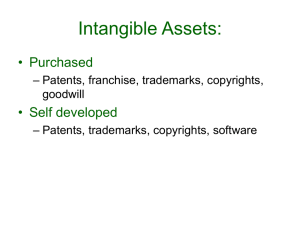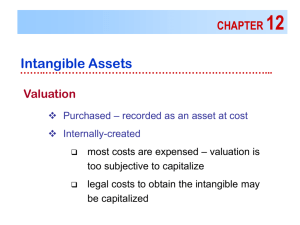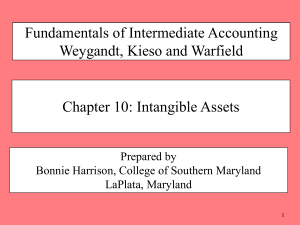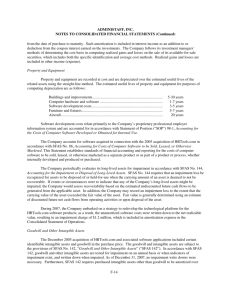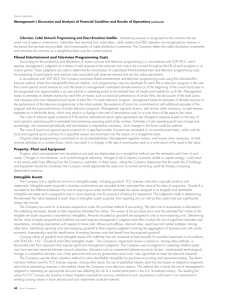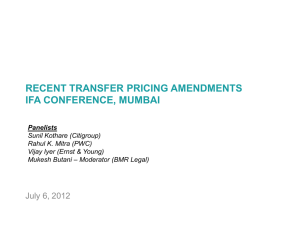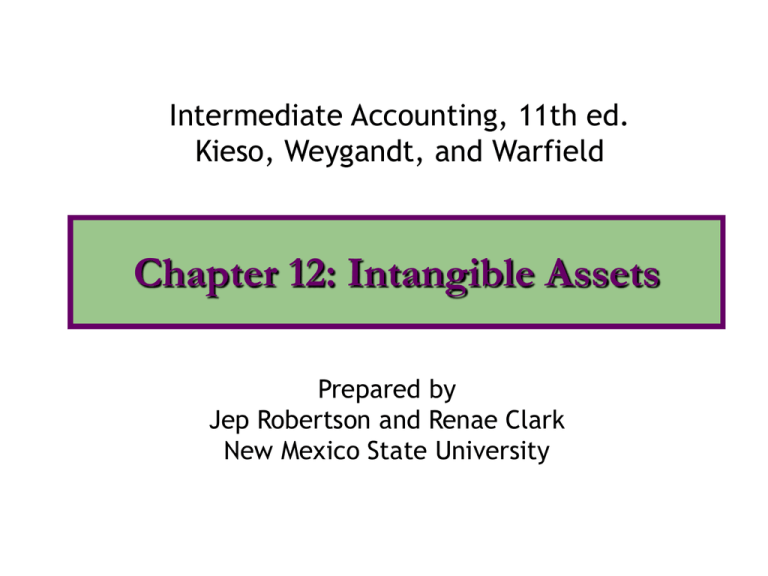
Intermediate Accounting, 11th ed.
Kieso, Weygandt, and Warfield
Chapter 12: Intangible Assets
Prepared by
Jep Robertson and Renae Clark
New Mexico State University
Chapter 12: Intangible Assets
After studying this chapter, you should
be able to:
1. Describe the characteristics of intangible
assets.
2. Identify the costs included in the initial
valuation of intangible assets.
3. Explain the procedure for amortizing
intangible assets.
4. Identify the types of intangible assets.
5. Explain the conceptual issues related to
goodwill.
Chapter 12: Intangible Assets
6. Describe the accounting procedures for
recording goodwill.
7. Explain the accounting issues related to
intangible asset impairments.
8. Identify the conceptual issues related to
research and development costs.
9. Describe the accounting procedures for
research and development costs and for
other similar costs.
10. Indicate the presentation of intangible
assets and related items.
Intangibles: Characteristics
• They lack physical existence
• They represent entity’s rights and
privileges
• They are not financial instruments
• They are long term in nature
Tangible Assets As a Percent of All
Assets
Classification of Intangibles
Intangibles are either grouped or
separately identified based on the
following factors:
•Are the assets developed internally, or
acquired singly or in groups?
•Is the expected benefit from the asset
limited or indefinite?
•Are the rights transferable or are they
a substantial part of the business?
Valuation of Intangible Assets
Intangibles
Purchased
Specifically
Identifiable
Capitalize
Goodwilltype assets
Capitalize
InternallyCreated
Specifically
Identifiable
Expense,
except
direct
costs
Goodwilltype assets
Expense
Amortization of Intangible Assets
• Intangibles are written off over their
useful lives, where the assets have
determinable useful lives.
• Where the intangibles have indefinite
useful lives, they are not amortized.
• Acquired intangibles should not be
written off at acquisition.
Specific Intangibles: Types
• Marketing-related (i.e., trademark, trade
name).
• Customer-related (i.e., customer lists,
customer relationships).
• Artistic-related (i.e., copyrights).
• Contract-related (i.e., franchise, licenses or
permits).
• Goodwill.
• Technology-related (i.e., product patent,
process patent).
Marketing-Related Intangibles:
Trademarks and Trade Names
• Trademarks and trade names are
renewable indefinitely by the original
user in periods of 10 years each.
• Costs of acquired trademarks or trade
names are capitalized.
• If trademarks or trade names are
developed by the a business, all direct
costs (except R&D costs) are
capitalized.
Customer-Related Intangibles
• Examples include:
• customer lists
• order or production backlogs
• customer relationships
• Amortized over useful life.
Artistic-Related Intangibles:
Copyrights
• Copyrights are granted for life of the creator
plus 70 years.
• Copyrights can be sold or assigned, but
cannot be renewed.
• Copyrights are amortized over their useful
life.
• Costs of acquiring copyrights are capitalized.
• Research and development costs involved
are expensed as incurred.
Contract-Related Intangibles:
Franchises and Licenses
• A franchise is a contractual agreement under
which:
• The franchisor grants the franchisee:
• the right to sell certain products or
services,
• the right to use certain trademarks or
trade names, or
• the right to perform certain functions,
within a certain geographical area.
Franchises and Licenses
• A franchise may be for a limited time, for an
indefinite time period, or perpetual.
• The cost of a franchise (for a limited time) is
amortized over the franchise term.
• A franchise (for an unlimited time) is carried
at cost and not amortized.
• Annual payments for a franchise are
expensed.
Technology-Related Intangibles:
Patents (Product Patents and
Process Patents)
• A patent gives an exclusive right to the
holder for 20 years.
• Costs of purchasing patents are capitalized.
• Costs to research and develop patents are
expensed as incurred.
• Patents are amortized over the shorter of
the legal life (20 years) or their useful lives.
• Legal fees incurred to successfully defend
patents are capitalized.
Goodwill
• Goodwill is the most intangible of all assets.
• Goodwill can be sold only with the business.
• Goodwill is the excess of:
• the cost (purchase price) over
• the amounts (price) assigned to tangible
and intangible net assets.
• Goodwill has an indefinite life and should
not be amortized.
Goodwill
• Internally created goodwill is not
capitalized.
• Purchased goodwill is recognized only when
an entire business is purchased.
• The initial valuation of goodwill is:
the excess of the purchase price over the
fair value of the net assets acquired.
• It is sometimes referred to as a master
valuation account (or a plug figure).
Goodwill Write-Off
• Acquired goodwill has an indefinite
life and should not be amortized but
is subject to impairment.
• Impairment test should be performed
at least annually.
• If applicable, loss recorded.
Negative Goodwill
• Fair value of net assets acquired is
higher than purchase price of assets.
• Resulting credit is negative goodwill
(badwill).
• FASB requires that any remaining
excess be recognized as an
extraordinary gain.
Intangibles: Impairments
An impairment occurs when:
• the carrying amount of an asset is
not recoverable, and
• a write-off of the impaired amount
is needed
To determine the amount of
impairment, a recoverability test is
used.
Impairment Tests
Type of Asset
• Property, Plant &
Equipment
• Limited Live
Intangible
• Indefinite-life
intangible, other
than goodwill
• Goodwill
Impairment Tests
• Recoverability test,then fair
value test
• Recoverability test, then fair
value test
• Fair value test
• Fair value test on reporting
unit, then fair value test on
implied goodwill
Impairments: The Recoverability
Test
Impairment?
Sum of expected
future net cash flows
from use and disposal
of asset is less than
the carrying amount
Sum of expected
future net cash flows
from use and disposal
of asset is
equal to or more than
the carrying amount
Impairment has
occurred
No impairment
Impairments: Measuring Loss
Impairment has occurred
Determine
impairment loss
Yes
Does an active market
exist for the asset?
No
Use company’s market
rate of interest
Loss =
Carrying amount
less
Fair value of asset
Loss =
Carrying amount
less
present value of
expected net cash
flows
Impairment: Accounting
Impairment has occurred
Assets are held
Assets are held
for use
for sale
1. Loss = Carrying value
less Fair value
2. Depreciate new cost basis
3. Restoration of impairment
loss is NOT permitted
1. Loss = Carrying value
less Fair Value less
cost of disposal
2. No depreciation is taken
3. Restoration of impairment
loss is permitted
Impairment Test: Fair Value Test
• Compares fair value of intangible
asset with assets' carrying amount.
• If fair value less than carrying
amount, impairment recognized.
Restoration of Impairment
• Assets held for use: impairment loss
may not be restored.
• Assets held for disposal can be written
up or down, as long as write-up is
never greater than carrying amount
before impairment.
• Losses or gains reported as “income
from continuing operations.”
Presentation of Intangibles
• Contra accounts are not normally shown.
• On the balance sheet, all intangible assets
should be reported as a separate item.
• On income statement, amortization expense
and impairment losses should be presented as
part of income from continuing operations.
• Unless goodwill impairment loss is associated
with discontinued operations, it should also be
reported as part of continuing operations.
Research and Development Costs
Research activities involve:
• planned search or
• critical investigation aimed at discovery of
new knowledge
Example:
Laboratory research aimed at discovery
of new knowledge
Merck’s R&D Disclosure
Research and Development Costs
• R & D costs involve searching for new
products and processes
• R & D costs are expensed unless the
costs have alternative future uses:
(examples)
• Lab costs aimed at new knowledge
• Conceptual formulation of possible
product
Presentation of R&D Costs
Disclosure is required in the financial
statements of the total R & D costs
charged to expense each period for
which an income statement is
presented.
Copyright
Copyright © 2004 John Wiley & Sons, Inc. All rights reserved.
Reproduction or translation of this work beyond that
permitted in Section 117 of the 1976 United States Copyright
Act without the express written permission of the copyright
owner is unlawful. Request for further information should be
addressed to the Permissions Department, John Wiley & Sons,
Inc. The purchaser may make back-up copies for his/her own
use only and not for distribution or resale. The Publisher
assumes no responsibility for errors, omissions, or damages,
caused by the use of these programs or from the use of the
information contained herein.

